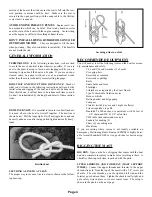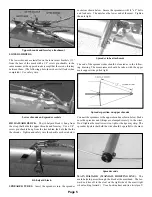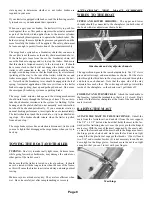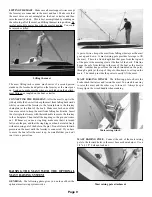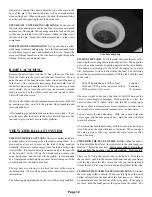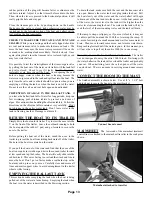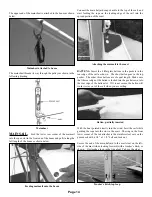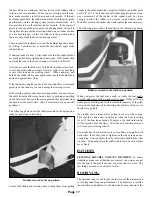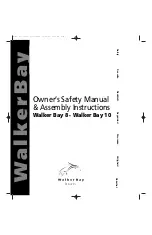
is metal, including the mast, shrouds, boom, lifelines, rudder, tiller
or metal hardware. If possible, don’t touch anything that is wet.
Many experts recommend that a heavy gauge copper wire be
securely fastened to one of the shrouds and allowed to hang in the
water to carry off the electricity from a lightning strike.
MAKE SURE THAT YOU TOW YOUR BOAT WITH
A LARGE ENOUGH CAR.
Check with your car manufactur-
er or dealer to determine if the weight of the boat and trailer is
within your car’s towing capacity. Load your boat so the weight
on the trailer hitch is between 250 and 300 pounds. If the weight
is less, the trailer will tend to swerve dangerously from side to
side. If the weight is more, an excessive load will be placed on the
rear end of your car, and the trailer will be very difficult to hitch
or unhitch. To protect your back when removing the trailer from
the car, use the hitch jack or have an adult hang on the back of the
boat to take some weight off the tongue.
NEVER OVERLOAD THE BOAT AND TRAILER.
THE MAXIMUM WEIGHT IS 4200 POUNDS, AS
SHOWN ON THE CERTIFICATION DECAL NEAR
THE HITCH, ON THE LEFT (PORT) SIDE OF YOUR
TRAILER.
Remember, the maximum gross vehicle weight
(G.V.W.R.) includes the weight of the trailer as well as the weight
of the boat and all gear in the boat. You may not deduct the weight
that is carried on the hitch of the car in arriving at the G.V.W.R.
Check your state law to determine if there are any other weight or
braking requirements that must be met.
MAKE SURE THE TRAILER WHEEL LUG NUTS
ARE TIGHT BEFORE TRAILERING THE BOAT.
BEFORE TRAILERING THE BOAT, MAKE SURE
THE NOSE OF THE BOAT IS TIED SECURELY TO
THE TRAILER.
MAKE SURE THE OUTBOARD MOTOR AND MAST
ARE ATTACHED FIRMLY TO THE BOAT WHEN
THE BOAT IS BEING TRAILERED.
DO NOT TRAILER THE BOAT WITH ANY WATER
IN THE BALLAST TANK. THE 1000 POUNDS OF
WATER WILL
SEVERELY
OVERLOAD THE
TRAILER AND THE CAR.
Open the transom valve and
vent, and drain the tank completely before trailering. Leave the
valve open when trailering.
DON’T STORE FUEL CANS INSIDE THE BOAT.
Gas
fumes are explosive. Keep all gasoline containers out of the boat.
Store fuel tanks in the open compartments next to the pedestal.
BATTERIES ARE DANGEROUS. TREAT THEM
CAUTIOUSLY.
Batteries can produce explosive gas, corrosive
acid and levels of electrical current high enough to cause burns.
Always wear eye protection or shield your eyes when working
near any battery and remove all metal rings and jewelry. Never
expose a battery to open flames or sparks. Do not smoke near a
battery. It could blow up. Do not allow battery acid to contact
eyes, skin, fabrics or painted surfaces. Flush any contacted area
with water immediately and thoroughly. Get medical help if eyes
are affected. Do not charge the battery, adjust post connections or
use booster cables without making sure the battery compartment
is properly ventilated. When charging the battery, carefully fol-
low the instructions on the charger. Keep the battery filled to the
proper level with distilled water. Always keep vent caps tight. Do
not allow metal tools or metal parts to contact the positive (+) ter-
minal and the negative (-) terminal or any metal connected to
these terminals.
DO NOT REMOVE ANY OF THE FOAM FLOTA-
TION BLOCKS.
Loss of any of the foam could seriously
impair the ability of the boat to stay afloat if damaged.
IF THE CABIN OF THE BOAT IS ENTIRELY
FILLED WITH WATER, AND THE BOAT IS DEPEN-
DENT ON THE FOAM FLOTATION TO KEEP IT
AFLOAT, IT WILL BE VERY UNSTABLE, AND MAY
TURN UPSIDE DOWN.
WHEN RAISING AND LOWERING THE MAST,
DON’T ALLOW ANYONE TO STAND WHERE THE
MAST OR SUPPORT WIRES COULD FALL IF
SOMETHING, OR SOMEONE, LETS GO.
BE EXCEEDINGLY CAREFUL WHEN SAILING IN
HIGH WINDS. LEARN BASIC SEAMANSHIP.
The
Coast Guard Auxiliary Power Squadrons offer excellent courses at
low cost. This is a worthwhile investment.
BE READY TO RELEASE SAIL CONTROL LINES
(SHEETS) QUICKLY IF A GUST OF WIND CAUSES
THE BOAT TO LEAN EXCESSIVELY.
L
ines should be
free of kinks and knots so they will run freely through the pulleys
when it is necessary to let the sails out quickly. Tie a knot in the
extreme end of the line to keep it in the pulley. Letting the lines
go is your best protection from a knockdown. For best perform-
ance under sail, and for safety, keep the boat from leaning (heel-
ing) more than about 20 to 25 degrees.
ALWAYS SHUT OFF THE OUTBOARD MOTOR
WHEN THE BOAT IS NEAR PEOPLE IN THE
WATER. EVEN WITH LOW HORSEPOWER
MOTORS, THE PROPELLER CAN DO SERIOUS
DAMAGE.
Don’t allow ropes to hang in the water (particular-
ly the rudder ropes). They could tangle in the prop and stop or
damage the motor.
DON’T PULL THE BOAT OVER ON ITS SIDE USING
THE MAIN HALYARD.
If you have to tip the boat for main-
tenance or for any other reason, use the jib halyard. Using the
main halyard will break the mast.
DO NOT SAIL OR POWER THE BOAT WITH THE
STEERING SEAT IN THE RAISED POSITION.
If the
Page 3
Содержание 26 M
Страница 28: ...Page 28...




